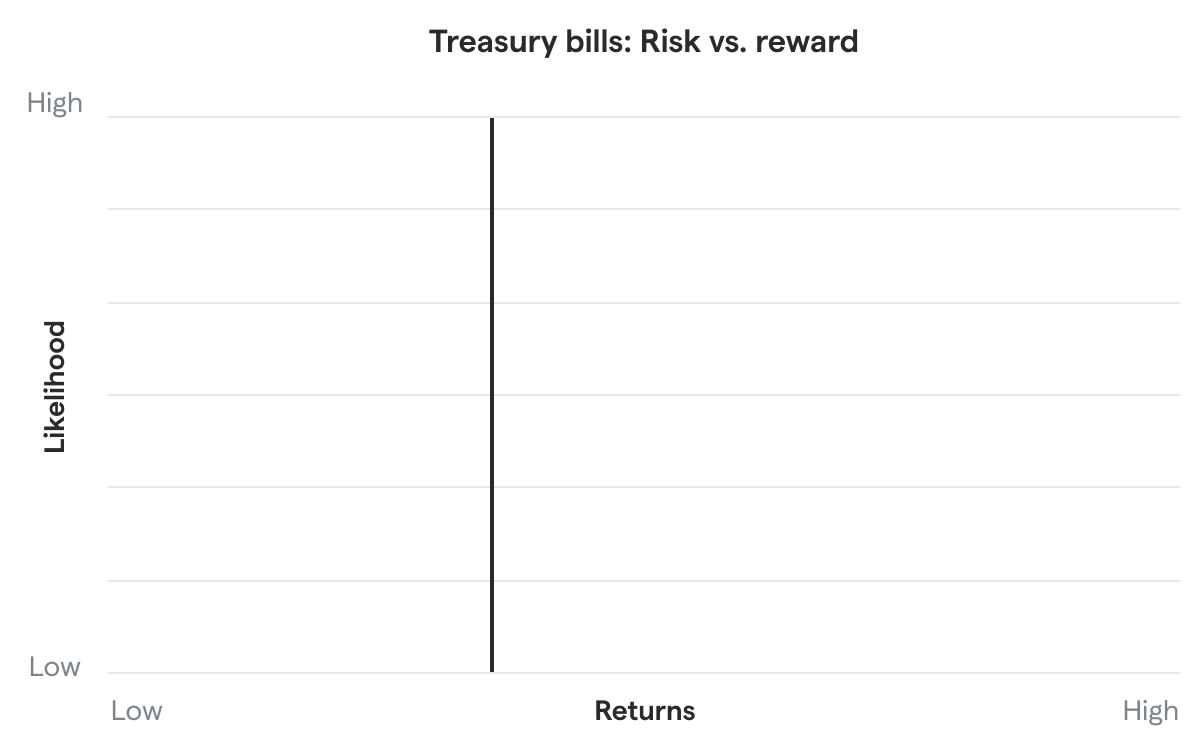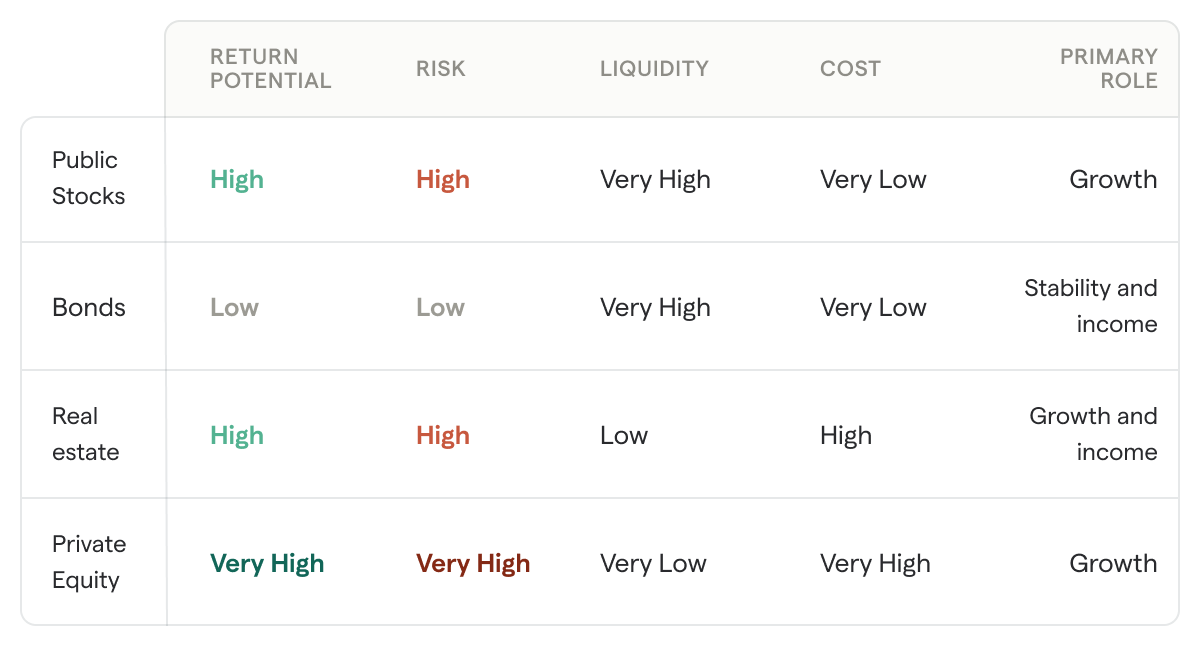🥇 The art of investing and outperforming the future
It’s John here, and I have the pleasure of writing this week’s newsletter. In our last one, Chris kicked things off with some insight into how you may want to think about setting financial goals for the new year.
I’d like to dive into something similar, but with a focus on the investing side. As you start to think about your investing strategy for the year — or even if you’ve never had an investing strategy before — I thought it’d be helpful to look at how to think about building an investment portfolio.
I touched on the art of picking (or not picking) stocks previously, but here I’ll dive into all the different factors that go into a “winning” portfolio.
My goal here is to help pull back the curtain a bit, and demystify what goes on in the investing world. That said, this stuff can still be tough to grasp, so I hope you’ll bear with me. And you can feel free to reach out to me by responding to this email if you have any feedback on what else I can help demystify, or if you have any questions about this week’s newsletter.
When you’re done reading this, make sure to check out our 2022 State of Stock Options report first published by TechCrunch (but it’s also on our site).
🤔 How do you win if the future is uncertain?
Let’s state the obvious: Investing is about risk and return. “Good” investing, however, is about being intentional about the risks you are taking and being rational about the returns you expect for taking those risks.

Unfortunately, there is no magic. Every few years we, as a society, get a reminder that magic in investing doesn’t exist, and if something sounds too good to be true — “little to no risk, but big returns!” – it probably is (FTX, XIV, LTCM, Archegos, and many, many others). So, given this truism, how do we build a portfolio designed to outperform without falling prey to claims of “magic”?
Let’s start with introducing the idea of uncertainty. Every asset, or portfolio of assets, has some range of possible outcomes. For example, an investment in a risk free short-term treasury bill has a narrow range of possible outcomes.
Its distribution of returns is pretty much a straight line. In other words, there is little to no uncertainty. You will get the interest paid on that bond. Because there is little uncertainty (risk), there is also little return (as of the writing of this post, 1-month T-bills are yielding 4.6% annualized).

Stocks are much less certain than short term government bonds, and for that risk, investors expect a greater return. Historically, the U.S. stock market as a whole, has outperformed treasury bills by ~ 8% annualized on average. But the road to that long-run average is bumpy!
The distribution of possible returns of the market may look something like this (For the market nerds, I know returns are not normally distributed like the picture, but this is an illustration of uncertainty, not an empirical model of stock returns.):

The expected return (or, the average of the distribution) is higher than the treasury bill, but there is a much wider range of possibilities — including losing money.
🙋♀️ So…how do you balance returns without too much risk?

Figuring out what the right mix of assets for you is about understanding the range of possible outcomes for the different assets available to you And then combining them in a way that makes sense for your goals and the risks you face in your personal life.
This is called “asset allocation”.
Despite what some “investors” say on Reddit or on TikTok, there are no “sure things.” Instead, risk and expected return are inextricably connected.
But you do want to ensure you are taking compensated risks instead of reckless risks. Remember the phrase, “fortune favors the brave.” Well, it doesn’t. The probability of success (fortune) does not necessarily increase with greater risks (the brave).
A key to successful long-term investing is understanding what risks you are taking and why. At Secfi, for example, when looking at the public markets, we shift the odds of success in our client’s favor by consciously taking appropriate risks in an attempt to shift the range of possible portfolio outcomes to the right.
Here’s an (admittedly basic) visual representation of moving to the right (i.e., better expected returns):

🧯One bad bet can burn down the house

Here’s a bit of fun market history for you to drive home the point. About 20 years ago, a hedge fund named the “Eifuku Master Trust” lost nearly $300 million of investor capital in one week.
Before blowing up, Eifuku actually had a stellar track record, and a reputation for having a pretty cheeky (and alliterative) name (to spell it out: “I f*$& you”). But risk only needs to bite once to lose that reputation and instead be known as a cautionary tale.
The reason Eifuku collapsed? The usual culprits, leverage, concentration, etc. But the underlying reason was that they were taking big, uncompensated risks that they didn’t understand or were too arrogant to imagine. (You can read more about it here).
The same story plays out with shocking regularity. See the examples of Long-Term Capital Management, the crisis in mortgage bonds in 2007/8, and more recently, XIV’s “volmageddon.”
📂 Remember, “portfolio” doesn’t equal “stocks”

Stocks are just one part of your portfolio. There are other asset classes to consider like bonds, real estate, and private equity. Each can play a role in your portfolio and each has its benefits and drawbacks.
At Secfi, for example, the portfolios we manage for clients seek to only take compensated risks in pursuit of outperformance. The way we do it is by positioning our client’s portfolios to benefit from systematic investment premiums and we expect to beat the market over the long-run as a result.
Here’s a high-level summary of the characteristics of these asset classes:

🔐 Yes, private equity can be an engine for portfolio growth
Private equity is the talk of the town right now because of its return history. So let’s dive into the considerations for including private equity in your portfolio.
Private equity is a broad category, but generally it just means ownership in private companies. The primary ways folks get exposure to private equity is by investing in a private equity or venture capital fund, making angel investments, or through stock compensation at a private company.
You’re likely reading this because you either have significant exposure to your employer’s private stock or you generated a significant portion of your wealth through ownership of your employer’s private stock.
📈 The difference between investing in the private and public markets
First thing’s first: Data on private equity funds is much harder to come by than public equity because…they’re private. However, in recent years, better datasets have been collected and analyzed by scholars and practitioners. And the available data across all private equity funds (both buyout and venture capital) does suggest that returns have been higher in private equity than in public equity.
A study first published in 2020, using returns generated from private equity funds raised from 1984 through 2015, showed that private equity funds, on average, outperformed the S&P 500 by roughly 3% per year through 2019.
The study also showed that performance among VC investors was persistently positive, a result not found for buyout funds or public equity fund managers. The authors hypothesize that the performance persistence is driven by the early stage of companies VCs invest in and the incentives that provides.
Here’s an excerpt from an interview with the author:
“Kaplan suggested that in buyouts the seller is often going to be looking simply for the highest bidder. This compares to a VC deal in which the seller still owns the majority of their company and, as such, has an incentive to choose the investor who can create the most value.
A VC firm with a reputation for creating value has an advantage in this scenario where the seller might take a lower valuation in order to work with a high performing firm.”
Seems plausible! There’s a sensible economic rationale for the outperformance of certain VCs. The data history isn’t as long or as standardized as public equities, but there is evidence of a return premium for private equity investing compared to the S&P 500.
🌹 But…it’s not all roses

Now for the downsides. While private equity investing has outpaced the S&P 500, it’s not a silver bullet that will lead you to riches. The main drawbacks of private equity are:
1. It’s illiquid
Private equity funds are structured to endure for several years with little-to-no control over the timing of the capital calls (putting money in) or the distributions (taking money out). It is possible to sell stakes in some private equity funds on the secondary market, if you can find a buyer.
Secondary markets are usually time intensive and costly. Some people view the illiquidity of private equity investing as a feature, and not a bug. It can certainly force you to hold your investments for the long-term, which may be a positive if you have difficulty hanging on during periods of market stress.
2. The fees are high
Private equity fund managers charge management fees and performance fees that often amount to multiple percentage points of the value of your stake each year. The typical structure for private equity is a 2% management fee and a 20% performance fee, meaning the fund’s general partners are paid 20% of all profits the fund generates. For context, an investment in Vanguard’s total world stock market ETF (VT) costs you 0.07% per year.
3. Minimum investment amounts are high
The minimum investment size in private equity funds is often hundreds of thousands of dollars, or even millions. Recent innovations have attempted to “democratize” private equity investing and have lowered minimums, but minimum check sizes are still tens of thousands of dollars. This check size may be prohibitive unless your portfolio is sufficiently large.
4. Diversification is challenging
You may have noticed that many buyout and VC funds are focused exclusively on specific sectors or company stages. This means, to build a diversified portfolio of private equity, you have to write multiple checks to multiple managers. Diversification may not be the main goal of the private equity portion of your portfolio, but I would be remiss if I didn’t point out that it’s not as easily diversifiable as an investment in public equities.
5. Access to the best can be restricted
The best managers in private equity don’t just let anybody into their club. Participation in their funds is sometimes restricted to institutional investors who write gigantic checks. But that is changing as technology is lowering the barriers to entry and allowing smaller investment sizes. We also intend to offer access to more diversified private equity funds through partnerships in the industry. We hope to open opportunities for our clients to invest in the best.
🎁 Let’s wrap this up

What does this all mean to you? Well, let’s go back to the asset allocation I briefly discussed earlier. There is no “right” allocation because each person’s circumstances, goals, and risk tolerance is different.
Including private equity in your portfolio may make sense if you have the asset base necessary to write large checks, and have the stomach for the risk and illiquidity. And if private equity is appropriate for you, how much of your portfolio should you commit?
The starting point for any asset allocation decision is the proportional size of the market or the “market weight”. Starting with the market weight is the default because any deviation from proportional weight is a bet against the aggregate. To put private equity in context, the value of all private equity (buyout and VC) was roughly $6 trillion as of June 30, 2021 while public equity (stocks) was ~$90 trillion. That makes private equity ~7% of the total equity market.
If you do want some private equity, 7% is a good starting point. You may even want to emphasize private equity in your portfolio in pursuit of higher returns. A 3x market weight to private equity would mean ~20% of an equity allocation in private equity.
The impact of increasing long-run returns is dramatic. In our toy example, if the public equity portion of the portfolio outperforms by 2% annualized (no small feat!) and if private equity continues its historical market beating rate of return (~3%), that would put the portfolio’s outperformance over the stock market at roughly 2.2% annualized. To put that into perspective, a $1 million portfolio invested for 30 years at 8% compound annualized returns would grow to ~$10 million. The same initial investment compounded at 10.2% would grow to $18.4 million. The power of compounding turns a 2.2% annual advantage into a 84% increase in wealth over an investment lifetime.
📝 What you should take away
Hats off to you if this is all making complete sense. But don’t worry if it’s not! The investment industry is rife with jargon and complexity. My point here is to illustrate that deciding on an asset allocation and then putting together the pieces of the portfolio to pursue compensated risks requires a fair amount of expertise.
My hope is that I was able to demystify what goes into building a portfolio — especially one that allocates private equity — a bit, even if just a little.
Ultimately, we all want our money to work for us. Your savings represents sacrifice and labor. Risking it foolishly like the Eifuku Master trust can be devastating, and irreparable. But there’s a better way to design a portfolio, asset allocation, and a financial plan that can ensure the risks you are taking with your money also come with expected benefits.
Things we’re digging:
- 🚨How did the bear market affect stock options? Do employees really have more than 80% of their net worth tied up in equity? Find out in our 2022 State of Stock Option report at TechCrunch (or for free here).
- 🐦Look at me, I’m on Twitter! Yes, I am trying to be more active over there, so hit me up, ask questions, and check out some analysis I did on reality vs. predictions from Q3 2022.
- 🎟️Live Nation, Ticketmaster, what’s the difference?! Swifties may have brought the ticketing giant back into the hot seat, but it remains to be seen if they’ll have any better luck than Pearl Jam did decades ago.